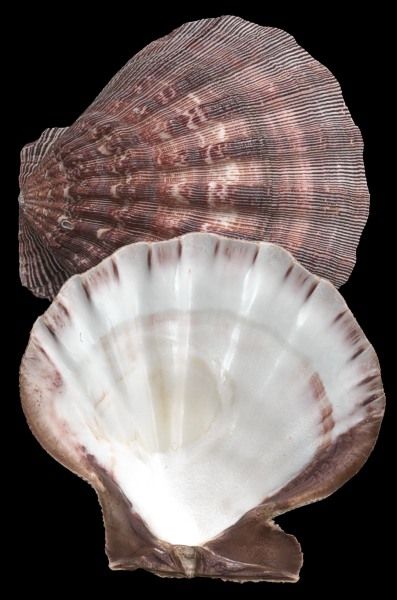One 5 to 6 inch Purple Lions Paw Single ******
One 5 to 6 inch Purple Lions Paw Single.
Orders usually process within 2 to 5 business days.
Email us at ja1@mindspring.com Make Your Selections and Shipping Preference. We Will Email You the amount of the Shipping Cost. When you receive the shipping cost go back into Shells of Aquarius and click into Purchase Shipping Label. There you will find UPS or USPS. Click into the option you decided on and make your payment. Your order will ship when shipping payment is received.
Nodipecten nodosus common name is the lion's paw scallop
the lion's paw scallop, is a species of bivalve mollusk in the family Pectinidae. It can be found along the Atlantic coast of North America, ranging from Cape Hatteras to the West Indies, including Brazil and Bermuda.
The lion's paw scallop is a species that consists of large scallop shells with ridges and bumps that have a rough texture. The lion's paw size can range from 2 1/2 to 6 inches long and are nearly circular. The shell is known for its distinct knobs on the ridges. The shell color ranges from red to orange and also purple. The shell's common name is derived from its appearance, the color, and the knobs giving it some visual similarities to the paw of a lion.
The lions paw is the largest scallop of the Western-Atlantic Ocean, it has been commercially fished for human consumption for decades. There has been a recent decline of fisheries along with an increase in the shell's value has led to aquaculture specific to the species. Their high growth rate makes them popular; however, not much is known about the requirements to improve farming. They are aqua farmed in the Caribbean particularly in Colombia due to their quick growth rate. Their popularity in commercial fishing near Brazil, makes the native lions paw at risk of extinction.
Lion's paw scallops are known to be hermaphroditic, so each species has both male and female gonads. In external fertilization, an organism will release both eggs and sperm. Lion's paw scallops spawn twice a year. Along the coast of Brazil, they are known to spawn once in the winter and once again in the summer.
The lion's paw shell is valuable to collectors because of its size, vibrant colors, and extremely distinctive features. Because of its large size and it being more common in deeper, rocky waters, they are rarely found intact on sandy beaches.
The lion's paw scallop is an epibenthic bivalve that usually lives on rocks inside of caves or in shaded areas.
Epibenthic refers to organisms That live on the surface of sediments at the bottom of the sea.
Scientific classification
Domain: Eukaryota
Kingdom: Animalia
Phylum: Mollusca
Class: Bivalvia
Order: Pectinida
Family: Pectinidae
Genus: Nodipecten
Species: Nodipecten nodosus
Binomial name: Nodipecten nodosus
(Linnaeus, 1758)
